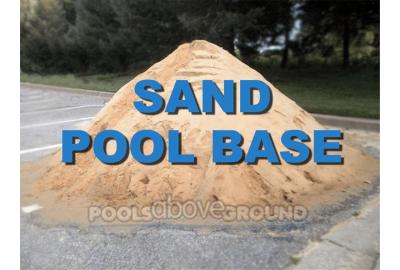When it comes to above-ground swimming pools, lots of people make the decision to handle the installation themselves. This is fine, as most relatively-handy individuals who know how to follow directions and possess some basic hand tools can do the job. However, even the most experienced DIY enthusiasts can get caught up when it comes to installing a proper base for their pool liner. To that point, we've come up with this handy and comprehensive guide to getting the job done right. When in doubt, it should have all the information you need.
Common Pool Base Problems
When it comes to self-installed above ground pools or pool liners, one of the most common problems we see relates to the height of the base beneath the above ground pool liner. When the sand base is not high enough, it puts too much strain on the wall and the liner itself. This can lead to a liner seam seperation or even cause the metal pool wall to collapse. Clearly, the liner is not meant to withstand the full weight of water, only to line the inside of the pool that actually holds the water in. This is why it is so crucial to make sure your liner is supported by a sand base of the proper height and design. Equally as bad is too much pool floor height. When this is the issue beaded, unibead or j-hook liners will become very wrinkly as there will be too much liner material in the pool and no way to adjust it or remove it.
Pool Base Basics
This is a very general idea of what you can or should do but if you live in Florida you may not need the additional sand at all because most of Florida is sand to start with. But for those of you that are fighting rocky, hard or other types of terrain the following advice will apply. Start by building your pool frame so that the floor of the pool is level with the pool frame rails. Build your frame too high on top of the ground and you're adding a ton of material inside the framework and creating a lot of extra work for yourself. Build it too low or recessed into the ground and you'll be removing a whole lot of material. If you set the frame height correctly you'll minimize the time you spend with a shovel in hand and minimize the amount of sand or fill that's required. If done correctly, a 2" to 3" deep bed of find mason or play sand is all you should ever need to create a smooth but still firm pool base. However, you also have to factor in a little more sand or fill for the pool cove. This is the angled section of sand that slopes against the pool wall, providing the much-needed support that holds your entire frame together.
Installation #1: Sand Base and Sand Cove
For this type (and all) installations, you need to make sure you're using only fine sand that is completely clear of rocks and debris. The first thing you want to do is build up to no more than 3" thick bed of sand across the entire interior of the pool wall. This will form your base. Use only enough sand to make the bottom smooth, too much and the pool floor will become soft and foot printy. This is hard to clean and very annoying so stick to the plan. Next, angle a layer of sand up to the edge of the wall. You more or less want to build a "ramp" that is 4" above the base at its highest point. This means that the entire sand layer resting against the pool wall will be no more than 7" high. When you put your liner in place, it should be completely supported by the sand base.
Installation #2: Sand Base and Foam Cove
Though you may or may not be able to completely remove sand from the equation, you can simplify this process immensely by opting for a foam cove. In this process, the first step of making the pool floor smooth by building a max of 3" base of sand remains the same. However, with the foam cove, you don't need to worry about building a "sand ramp" up to your pool wall. Instead, you will use the foam to form the solid corners. Merely remove the adhesive, and stick it to the inner part of the pool wall, just on top of the sand base.
Alternate Installations
Some installations may call for a liner pad. In my opinion a good floor pad like Armor Shield is a wise investment. They add an almost impenetrable layer of protection for the underside of your pool liner. Aside from the piece of mind, it helps keep the sand from shifting and provides a smoother and more protective base for your liner. When installing one of these, you should put it on top of the base and the foam cove. This will more evenly compress the sand as you fill the pool with water. In the end, the base is the foundation of your above ground pool. It needs to be strong, properly shaped, and made of the right materials. Whatever type of installation you decide on, be sure to take your time getting the base "just right." Need installation tips or additional info about creating a pool base or cove just call us at (866) 534-9725 or visit our website at http://poolsaboveground.com/







